
The Messerschmitt Me 210 was a German heavy fighter and ground-attack aircraft of World War II. Design started before the war, as a replacement for the Bf 110. The first examples were ready in 1939, but they proved to have unacceptably poor flight characteristics due to serious wing planform and fuselage design flaws. A large-scale operational testing program throughout 1941 and early 1942 did not cure the type's problems. The design entered limited service in 1942, but was soon replaced by the Messerschmitt Me 410 Hornisse, a further development of the Me 210. The failure of the Me 210's development program meant the Luftwaffe was forced to continue operating the Bf 110 after it had become outdated, despite mounting losses.

The Blohm & Voss BV 155 was a German high-altitude interceptor aircraft intended to be used by the Luftwaffe against raids by USAAF Boeing B-29 Superfortresses. Work started on the design as the Messerschmitt Me 155 in 1942, but the project went through a protracted development period and change of ownership, and prototypes were still under test and development when World War II ended.

The Messerschmitt Bf 109 is a German World War II fighter aircraft that was, along with the Focke-Wulf Fw 190, the backbone of the Luftwaffe's fighter force. The Bf 109 first saw operational service in 1937 during the Spanish Civil War. It was still in service at the end of World War II in 1945. It was one of the most advanced fighters when it first appeared, with an all-metal monocoque construction, a closed canopy, and retractable landing gear. A liquid-cooled, inverted-V12 aero engine powered it. It was called the Me 109 by Allied aircrew and some German aces, even though this was not the official German designation.

The Messerschmitt Bf 110, often known unofficially as the Me 110, is a twin-engined Zerstörer, fighter-bomber, and night fighter (Nachtjäger) developed in Nazi Germany in the 1930s and used by the Luftwaffe during World War II. Hermann Göring was a proponent of the Bf 110, believing its heavy armament, speed, and range would make the Bf 110 the Luftwaffe’s premier offensive fighter. Early variants were armed with two MG FF 20 mm cannon, four 7.92 mm MG 17 machine guns, and one 7.92 mm MG 15 machine gun for defence. Development work on an improved type to replace the Bf 110 - the Messerschmitt Me 210 - began before the war started, but its shakedown troubles resulted in the Bf 110 soldiering on until the end of the war in various roles. Its intended replacements, the aforementioned Me 210 and the significantly improved Me 410 Hornisse, never fully replaced the Bf 110.

The Focke-Wulf Fw 187 Falke ("Falcon") was a German aircraft designed in 1935. It was conceived by Kurt Tank as a twin-engine, high-performance fighter, but the Luftwaffe saw no role for the design, perceiving it as intermediate between the Messerschmitt Bf 109 and Bf 110. Later prototypes were adapted to two-seats to compete with the Bf 110 in the heavy fighter (Zerstörer) role, but only nine aircraft were built in total.

The Avia S-199 is a propeller-driven Messerschmitt Bf 109G-based fighter aircraft built after World War II using the Bf 109G airframe and a Junkers Jumo 211F engine in place of the original and unavailable Daimler-Benz DB 605 engine. It is notable as the first fighter obtained by the Israeli Air Force, and used during the 1948 Arab-Israeli War.
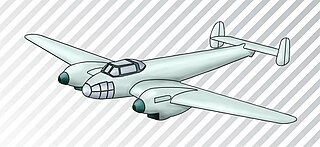
The Messerschmitt Bf 162 was a light bomber aircraft designed in Germany prior to World War II, which flew only in prototype form.

The Me 209 of 1943 was an attempt to create an enhanced version of the Bf 109, which served as the Luftwaffe's primary fighter aircraft throughout World War II. The Me 209, despite its designation, bore no relationship to the earlier Me 209.
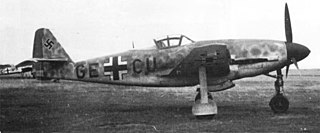
The Messerschmitt Me 309 was a prototype German fighter, designed in the early years of World War II to replace the Messerschmitt Bf 109. Although it had many advanced features, the Me 309's performance left much to be desired and it had so many problems that the project was cancelled with only four prototypes built. The Me 309 was one of two failed Messerschmitt projects intended to replace the Bf 109, the other being the 1943 Me 209 project.

The Messerschmitt Me 609 was a World War II German project which joined two fuselages of the Me 309 fighter prototype together to form a heavy fighter.

The Daimler-Benz DB 605 is a German aircraft engine built during World War II. Developed from the DB 601, the DB 605 was used from 1942 to 1945 in the Messerschmitt Bf 109 fighter, and the Bf 110 and Me 210C heavy fighters.

The Focke-Wulf Fw 57 was a prototype German heavy fighter and fighter-bomber. Prototypes were built in 1936 but never entered production.
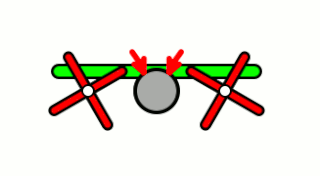
Counter-rotating propellers (CRP) are propellers which turn in opposite directions to each other. They are used on some twin- and multi-engine propeller-driven aircraft.
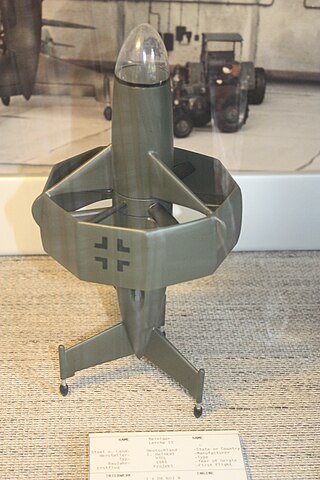
The Heinkel Lerche was the name of a set of project studies made by German aircraft designer Heinkel in 1944 and 1945 for a revolutionary VTOL fighter and ground-attack aircraft.
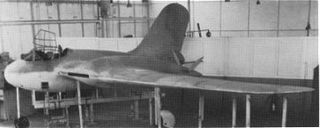
The Messerschmitt Me 329 was a design project for a heavy fighter and ground-attack aircraft, developed towards the end of World War II. It was a competitor and possible successor to the Me 410. Like the Me 265, the Me 329 used an advanced flying wing design. Other advanced features included the pilot and navigator sitting side by side in a broad bubble canopy, and a remote-controlled rear gun in the tail. In spite of the futuristic design, the improvement in performance over the Me 410 was marginal. Development received a low priority, and while a full-scale glider was tested at Rechlin in the winter of 1944/5, work on the project was cancelled shortly after.
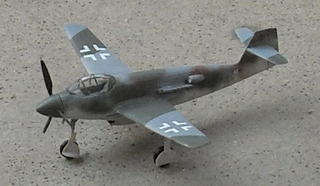
The Messerschmitt Me 509 was an all-metal fighter project, underway in Germany during World War II.

Due to the Messerschmitt Bf 109's versatility and time in service with the German and foreign air forces, numerous variants were produced in Germany to serve for over eight years with the Luftwaffe. Additional variants were produced abroad totalling in 34,852 Bf 109s built.
The Caproni-Campini Ca.183bis was an Italian projected high-altitude fighter intended to have both piston and jet propulsion.

The IMAM Ro.58 was an Italian twin-engined, two-seat monoplane heavy fighter and attack aircraft, a development of the IMAM Ro.57. First flown in May 1942, it was considered a general improvement over its predecessor, mainly due to the substitution of higher power Daimler-Benz DB 601 engines for the Fiat A.74 engines used on the Ro.57. Initially it had many problems and during the maiden flight only the proficiency of the test pilot, Adriano Mantelli, saved the plane.
The Henschel P.87 was a proposed single-engine Schnellbomber design put forth by German aircraft manufacturer Henschel for the Luftwaffe during WWII. It was to utilize the then seldom-used tail-first canard arrangement, swept wings, and two vertical fins mounted on the wingtips.



















